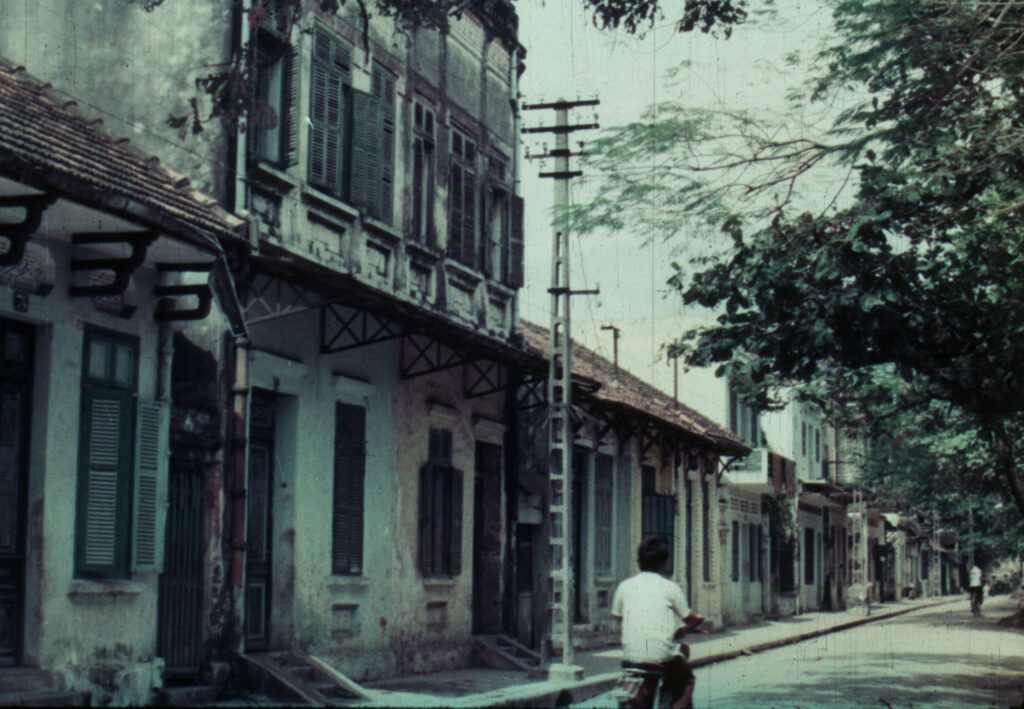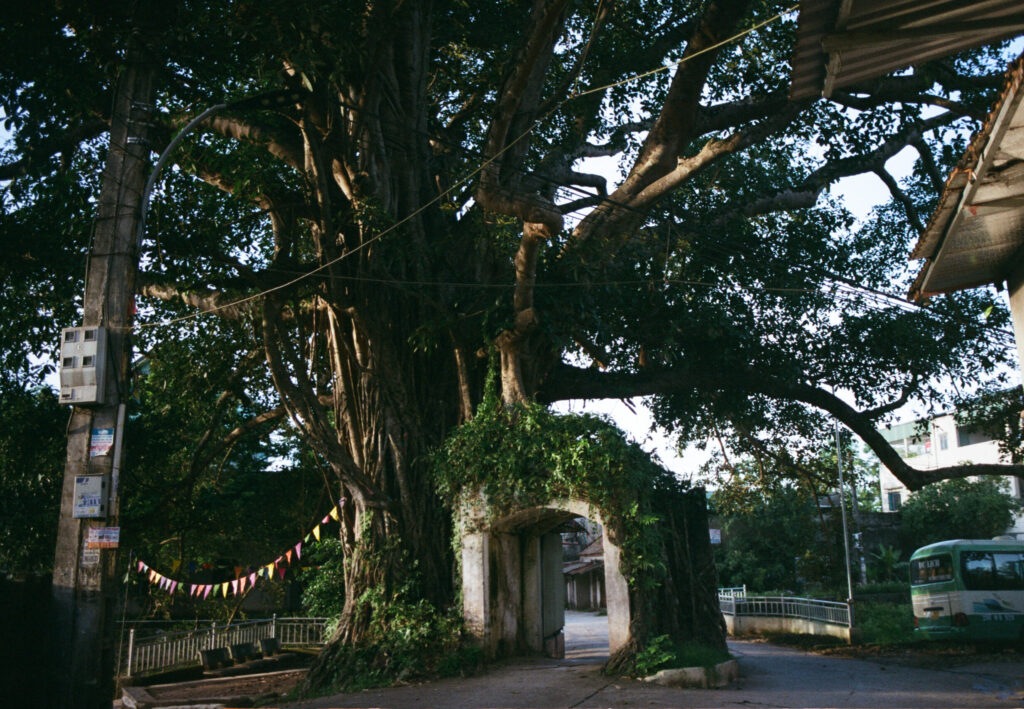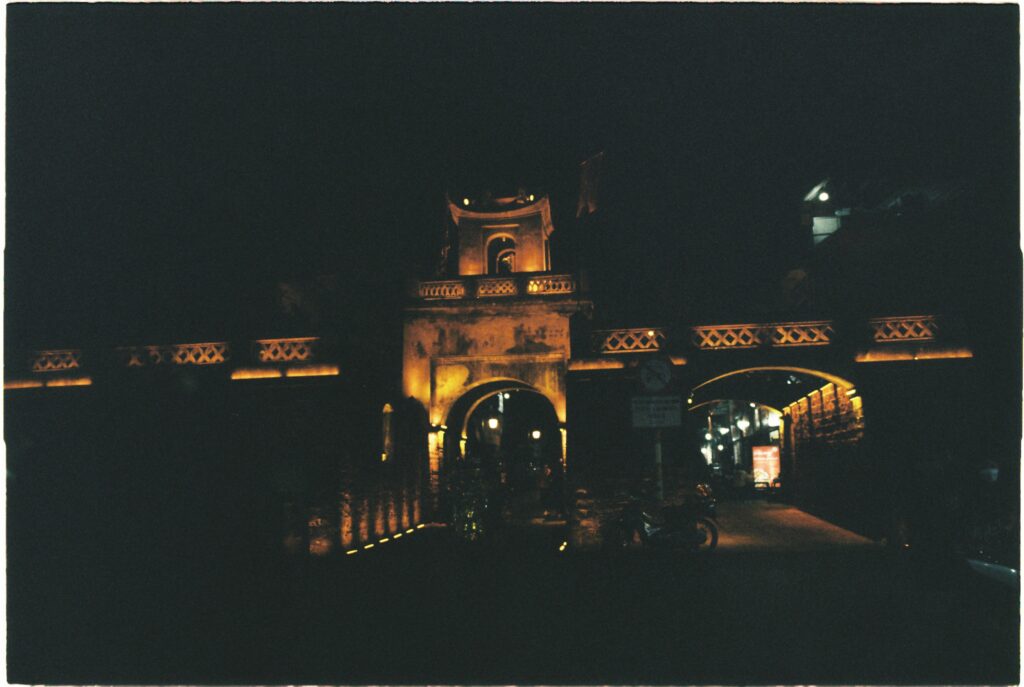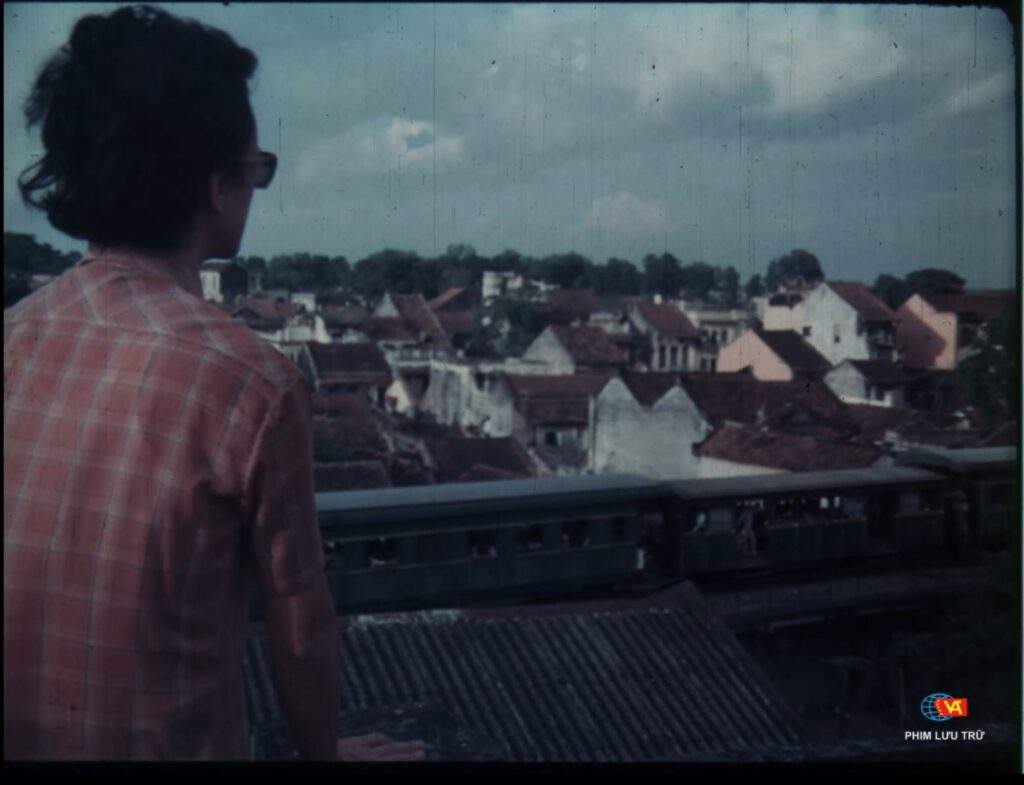In the early 1980s, acclaimed documentary filmmaker Trần Văn Thủy requested a script for his new film. The script he received was titled Hanoi, Five Old City Gates. Written by Đào Trọng Khánh, the film was supposed to promote tourism to Hanoi by celebrating the capital city’s attractions and traditions. During the difficult years before the Đổi Mới reforms (which brought economic prosperity to Hanoi), however, Thủy found no outward elegance in the city. The director turned towards the timeless values rooted in Hanoi’s ancient past and the spirits of contemporary artists who understood the city’s essence. To Thủy, those spiritual and philosophical principles were the city’s true and invaluable beauty. Hanoi Through Whose Eyes? is Trần Văn Thủy’s meditation on the stories of Vietnam’s capital over the ages and the poignant lessons they left for future generations.
Watching Hanoi through the documentarian’s eyes conjures up vivid memories of my childhood. Despite taking place more than two decades after the film was made, my Hanoi blends seamlessly with the city in the film. In one memory, I walk beside my father, whose thick, blunt hand holds on to mine. Beneath my feet are brick pavers with colours of faded green and red, and cracks that blend into their carvings. My father wears a stern expression. The faint, crooked lines of his face seem like they have been laid down with a writing brush held by quivering, uncertain hands. Under the shade of the xà cừ trees and away from the afternoon sun, his rough skin glows a soft green hue, as though the shadow of a bygone era has fallen across his face.
In that bygone era, the time of Hanoi Through Whose Eyes?, my father was about the same age as I am now. I wonder if the rows of xà cừ been planted yet. Were there already cracks on the brick pavers? What did Hanoi through my father’s eyes look like?

Still from Hanoi Through Whose Eyes?
The film begins on the balcony of number 51 on Hàng Giấy street, where blind guitarist Văn Vượng is playing a tune. His melody is in perfect harmony with the buoyant rhythm of contemporary Hanoi’s briskness and the subtle resonance of the city’s treasured history. Văn Vượng’s guitar paints an ageless portrait of Hanoi, complete with its busy traffic and the majestic crowns of ancient banyan trees. And yet, he himself has never seen the city. Somewhere else in Hanoi, famed painter Bùi Xuân Phái is absorbed in his work. Hanoi’s soul gleams in his eyes and dances on the canvas with every firm, sure stroke of his paintbrush. The old buildings and their slanted roofs quietly come into view, as if a long-forgotten memory is being called to mind. Bùi Xuân Phái’s painting revels in its humility and subtle melancholy, which captures the ever-shifting, eternal nostalgia of Hanoi. In contrast to the artists’ work, the people of Hanoi have become oblivious to the city’s ancient elegance. In a café blasting ABBA, where the walls are adorned with posters of Suzi Quatro and The Beatles, young people dress up and sit around small tables, enjoying smokes. Speaking to the camera, one of them suggests that Hanoi’s humble historical monuments cannot measure up to other countries’ architectural artistry. Director Trần Văn Thủy seems to be in ardent disagreement with such superficial comparisons. He argues that it is not architecture and aesthetics, but the culture and spirit of the people that make a city — specifically Hanoi — distinct. Thủy cites the book Histoire Naturelle Civile et Politique du Tonkin, where the abbot Jérôme Richard describes 18th century Kẻ Chợ’s rivers as so busy and robust with people doing trade that not even the rivers of Venice could compare.

Still from Hanoi Through Whose Eyes?
Kẻ Chợ is a folk name of Hanoi. Chợ means “market,” underlining the city’s bustling trading business. The modern name Hanoi also addresses the city’s individual culture, but this meaning was obscured through anglicisation, which discourteously effaced the space between Hà” — “river,” and Nội” — “within.” A city within rivers, Hà Nội once owed much of its vibrant culture and trade to the waterways that still flow through it. Today, however, rapid industrialization and urbanization have left these rivers severely polluted. Growing up on the southeast side of the city, I became too familiar with the deathly dark color of the Tô Lịch river. I remember the nausea in my father’s old car as the river’s malodour crept through the air-conditioning in the standstill of rush-hour traffic. One time, our car was next to a cargo tricycle driven by an old war veteran in an army-green uniform. There were so many of these veteran-owned cargo tricycles in Hanoi that they had been called “the steed of wounded soldiers.” My father is a war veteran himself, having served as an infantryman with the 304th Division in the 2nd Corps of the National Liberation Front. Again and again, he would talk bitterly about how many of his wartime friends had grown frail or were long gone. Sometimes, when revolutionary songs came on the car radio, my father would unconsciously sing along, then retreat into silence when he noticed me listening. That day, while stuck in traffic, my father suddenly rolled down the car window. The thick stench of the Tô Lịch, mixed with the summer heat and the haze of exhaust fumes, rushed into the car. Holding my breath, I watched my father lean out to speak with the veteran on the cargo tricycle. He handed the old man a bottle of water and an army ration biscuit. Soon, the traffic dispersed and as we hurried home for dinner, my father fell into a quiet, sullen trance. As time has gone by, people like my father and the old veteran became alien to the world around them. The people of the new age greet them with perfunctory nods of feigned respect and leave them behind, just as they left the once magnificent rivers of Hanoi befouled.

Still from Hanoi Through Whose Eyes?

Old Village Gate at Hồng Phong Commune, Chương Mỹ District, Hanoi by Đăng Tùng Bạch
Perhaps it is this quiet and neglectful forgetting that Hanoi Through Whose Eyes? seeks to resist. With the film, director Trần Văn Thủy urges the audience to look back and see the layers of history buried within the capital’s soil. The camera drifts gently with the ripples of Hanoi’s West Lake, whose clear water reflects the sun through a floating veil of mist. Reciting famous proverbs and poems connected to the scenery, the film moves into Trấn Võ (now Quán Thánh) Temple, one of Thăng Long Tứ Trấn – Hanoi’s Four Guardian Temples. Inside, a towering statue of Trấn Võ, god of the North Star, sits solemnly on his throne. In the temple, the film discovers another statue, which is of the craftsman who sculpted Trấn Võ’s image. Praising the ancestors’ tribute to the artisan, Thủy suggests that such official recognition must have nurtured the devotion of many talented people in the past. The film continues along West Lake’s shore to enter Trấn Quốc Pagoda, the capital’s oldest Buddhist temple. “Trấn Quốc” means “to protect, to calm a nation.” The film explains that the pagoda’s name, along with the enveloping warmth of its architecture, evoke the past generations who dedicated their lives to keep the nation’s peace. Mournfully, Trần Văn Thủy recites an elegy by the 19th-century poet Lady of Thanh Quan District in tribute to these forebears.
Still reflecting on the Lady of Thanh Quan District, Trần Văn Thủy recalls how one of her verses inadvertently costed her husband his position as district chief. The director laments, “Oh, to know how troublesome it is when the arts become tangled up with politics!” Discussing the political turmoil taking place in Hanoi throughout history, the film speaks about pioneering 14th-century scholar Chu Văn An being disregarded by the “foolish” king Trần Dụ Tông, and of 15th-century revolutionary heroes Nguyễn Trãi and Trần Nguyên Hãn meeting harrowing fates because of king Lê Lợi’s suspicions. The film’s most memorable lesson from history is the tale of Nguyễn Huệ, later known as Emperor Quang Trung, who visits king Lê Cảnh Hưng in the 18th century. When Nguyễn Huệ enters the king’s court, his sword still hangs at his side, scaring the gathered vassals. Only Phương Đình Pháp steps forward to politely remind him that no weapons were allowed before the king. Though taken aback, Nguyễn Huệ entrusted his sword to the attendant. With a stately tone, narrator Trần Đức declares that the interaction made Nguyễn Huệ realize “a nation can only prosper if civilians dare speak what is righteous and those with authority can hear reason.” According to Trần Văn Thủy, it was perhaps this principle that granted Quang Trung the character 心 (Tâm), meaning “heart and mind,” carved above his monument in Hanoi’s Bộc Pagoda.

Hóa Vàng (Paper Offerings Burning) by Đăng Tùng Bạch

Tết in Hanoi by Đăng Tùng Bạch
When Hanoi Through Whose Eyes? was filmed, the fragile peace following Vietnam’s reunification in 1975 and ongoing Cold War tensions had put the nation on alert of anti-government dissent. The film seems to use the past to comment on the present, reflecting Trần Văn Thủy’s frustration with the ingratitude for artists during Vietnam’s “subsidy period.” Criticizing former kings for mistreating well-meaning individuals and praising Emperor Quang Trung’s support for open dialogue, Hanoi Through Whose Eyes? appears as a veiled critique of contemporary authorities — one that led to intense scrutiny and censorship for both the film and its director.
In an interview published on Hà Nội Mới newspaper, Thủy reminisces that Prime Minister Phạm Văn Đồng happened upon the film and, impressed by its message, requested a nationwide release. Despite the prime minister’s order, the film took several years to reach the public. Completed in 1982, it did not formally premiere until 1987. By that time, the subsidy period had ended and the Đổi Mới reforms had already taken effect. Hanoi Through Whose Eyes?, previously banned for “invoking the past to speak about the present,” arrived in theatres already a relic of another era. Its resonance, however, has only deepened over time, continuing to inspire those from the namesake city, myself included, to remember their roots.

Quan Chưởng Gate by Đăng Tùng Bạch
Since I moved from Hanoi to Naarm (Melbourne), I always look forward to my annual returns for Tết with both pleasure and dread. As spring arrives, carrying peach blossoms and budding leaves, the chilly winds of change blow through the capital and an anxiety takes root within me: What if I no longer recognize Hanoi?
Watching Hanoi Through Whose Eyes?, I feel a sense of unease every time a familiar monument appears. The film’s lonely Quan Chưởng Gate is a far cry from the one I know, which is always surrounded by rows of parked motorbikes belonging to customers of wonton noodle shops. But some remain the same, such as the exhibitions of the Vietnam National Museum of History. Together, these monuments affirm to me the unpredictable and varied effects time has on Hanoi. In the five years I have been in Naarm, Hanoi has completed its long-delayed skytrain, restructured its roads and even treated the once-contaminated Tô Lịch River. Seeking refuge from Hanoi’s rapid changes, my mind drifts back into that childhood memory I have of the city, where my father and I walk together through our neighbourhood. We arrive at a large empty plot of land just as the sun begins to set. There, the weeds are nearly twice my height. When the sun finally disappears behind the horizon and the wisteria-coloured veil of the evening drapes over the sky, I catch sight of small glimmers floating in the air. Fireflies. Hundreds of fireflies dancing slowly to the low hums of the cicadas. As my father carries me through the tall weeds, I stretch my small hands toward the drifting lights, but the fireflies vanish before I can reach them…
Recently, I learned that an elementary school was built on that plot of land. A building painted with bright colours now stands where the tall weeds once grew, and in place of the fireflies are children taking their first steps in the journey of education. These young students are the same age as I was in that memory I hold so dear. Now, when I watch Hanoi Through Whose Eyes?, I wonder what Hanoi looks like in the eyes of these schoolkids. Does it have the quiet charm of Bùi Xuân Phái’s paintings? Does it have euphonious melodies like the songs of Văn Vượng? Does it still hold the ancient elegance that Trần Văn Thủy cherishes? As the wheel of time keeps on turning for me and my father, the Hanoi of our memories will disappear from view like the faint light of the fireflies I failed to reach.

Still from Hanoi Through Whose Eyes?
Hanoi Through Whose Eyes? played as part of the ‘Memories of a Vietnamese Cinema’ series co-presented by Metrograph and the Vietnam Film Institute.
Ariana King


